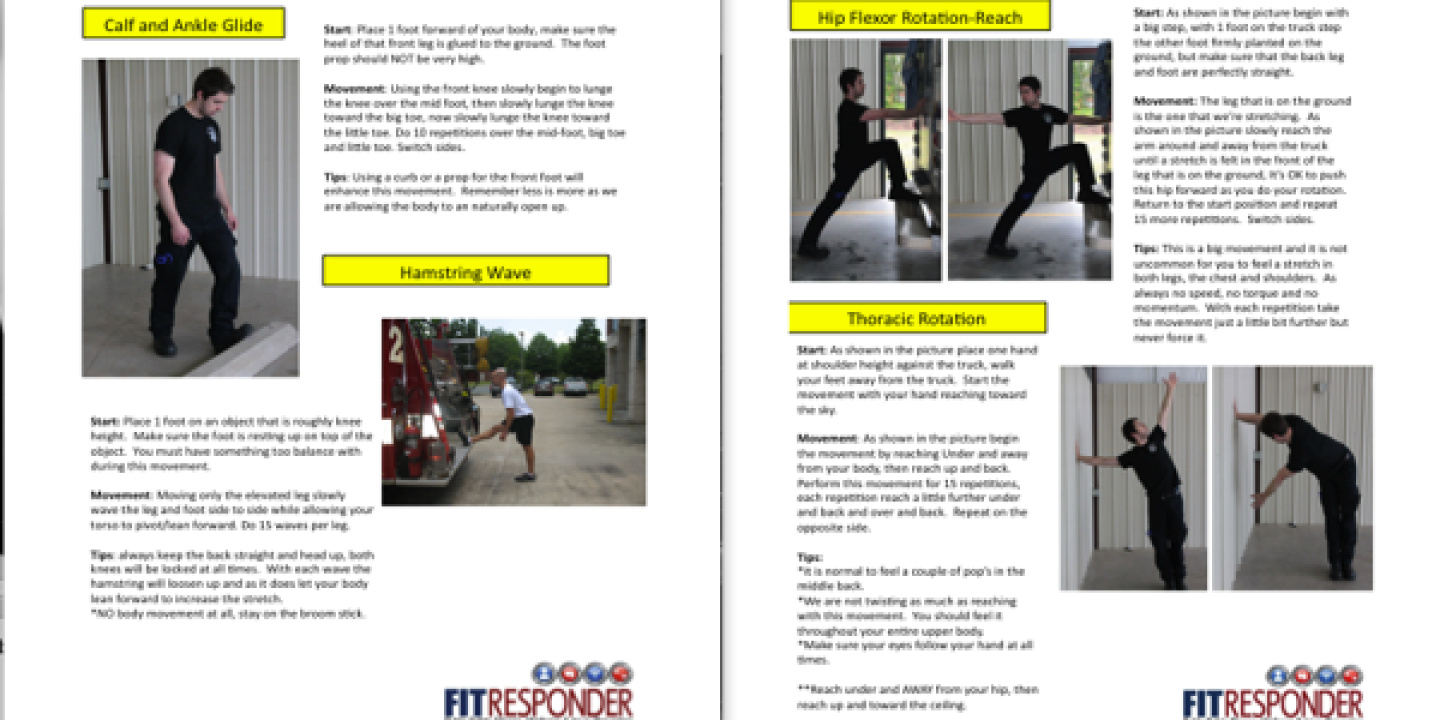It’s zero dark thirty as you come trudging into the station for shift change. Your body is sore from the busy shift you had the day before at your volunteer department; a working fire and an entrapment on the same shift, and your body can feel it.
After chatting with your buddy from the off-going crew, you begin to check off the truck and your gear and the first call of the shift just got dispatched: “Smoke in a residence.” As you climb into the truck your back lets you know that it’s not happy with you.
If we look at other professions that move heavy objects and engage in extreme physical work, most of them have mandated pre-shift stretching. The data is very clear; organizations that have in place a valid, job-specific pre-shift stretching program have lower injury rates.
On top of that, these same organizations have higher participation in wellness programs and have improved morale. The fire service is the perfect vehicle for a structured stretching program.
Truck check
At the start of every shift there is a routine that for the most part happens on its own. The apparatus and gear is checked off, station duties are completed and any secondary tasks are handled.
The science is very clear, after you have checked off the truck and gear, essentially making it ready, it’s time to check off you. Never thought of it that way, did you?
Frankly, it amazes me that we invest so heavily in gear and apparatus yet spend so little time investing in the only thing that makes the gear and apparatus work, you. For the sake of argument, here is my take on how this works, and we know it works because we have dozens of departments following this approach with great success.
1. Never stretch cold. While we all know this, it needs to be stated. Muscles and joints move much better when they are warm, that’s why we usually do a warm up prior to stretching.
The good news is that simply checking off the truck is enough of a warm up to then safely stretch. Of course, a few minutes on the foam roller is always a good idea, too.
2. They have to be valid. There is a lot of myth and misinformation on stretching. Take arm circles as an example, a favorite “active stretch” that does no good. In fact we believe that they can cause bone spurs.
So all the stretches must be safe, effective and job specific. Plus, they must benefit everyone not just the folks who are already in shape.
3. They have to be quick. Let’s face it, as a whole we are all a little bit lazy. When you are on for 24 or 48, the rule of thumb is self-preservation so we will do as little work as possible to preserve our energy. Plus you never know when the tones will go off, so the stretching protocol has to be efficient.
4. No one likes to lie on the floor. Unfortunately many of the best stretches are done lying on the floor. But I know these three things to be true: no one likes it; some are afraid they cannot get back up; and who the heck knows what’s on the bottom of your boots.
From a sports-medicine and biomechanics standpoint, we know that there are four areas of the body that contribute to most injuries. If how we move matters and how we move matters in how we reduce injury risk, then our stretches must tie into that. The stretches must address four areas.
1. The foot, ankle and calf. When your contact point to the ground is altered or tight, everything above it is affected in a bad way. If you have used a foam roller on your claves, then you know just how bad and just how important calf and foot flexibility really are.
2. The hips and glutes. We all have a tighter hip. If your left hip is tighter, by say 20 percent, he data shows that that 20 percent tightness equals a 60 percent greater chance of injury on that side. If we know it’s there, we can fix it.
3. The hip flexors. We sit too much and we do, or did, too many exercises that affected the hip flexors. When they get tight they cause the abs to shut off and that affects your lower back.
4. The thoracic spine and upper back. From your SCBA to sitting in the truck to hunched over a computer your upper back is a mess.
The rules for our four active stretches are simple.
- No speed.
- No bouncing.
- No momentum.
- Go slow.
- Do 15 reps per side and let the body open it’s self-up.
- Do not force it, let it happen naturally.
When you are checking off your body and you feel something grab, spasm, catch or it just feels stiff — that is a symptom. You cannot afford to ignore symptoms, as those warning signs can become your next injury. When the “check engine light” in your body comes on, use the foam roller, tennis ball or a passive stretch to manage the tightness so that your chance of getting hurt is drastically reduced.
Stretch every shift, and there is nothing wrong with going through them a second time 12 hours later. The final point is this: if you follow the order shown working from the ground up and there is no rest between movements, the entire routine takes less than 4 minutes.
Four minutes is nothing, and when it reduces roughly 50 percent of firefighters’ soft tissue strain and sprain injuries, we all go home feeling and moving better.













